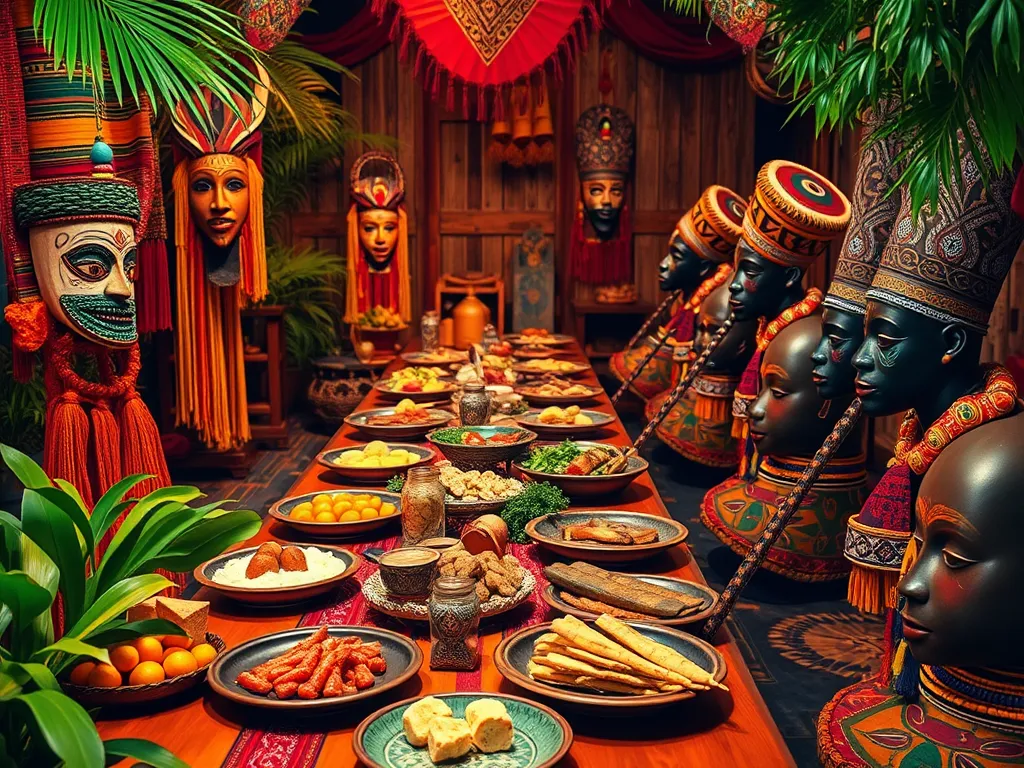
Celebrating the Matumbo Feast: A Joyous Cultural Tradition
The Matumbo Feast is a vibrant and essential celebration within many African communities, bringing together people in a joyous atmosphere filled with rich cultural expressions. This annual event honors the bounty of the land, with a particular focus on the traditional delicacies that are central to the festivities. As communities gather, the Matumbo Feast serves not only as a celebration of food but also a reaffirmation of cultural identity and communal ties.
At the heart of the Matumbo Feast is the time-honored tradition of communal cooking and sharing of meals. Families prepare various dishes that showcase local ingredients, with the centerpiece often being a heavily spiced stew made from goat or chicken, symbolizing abundance and prosperity. This sharing of food fosters a sense of togetherness and reinforces the importance of family and community bonds, making Matumbo Feast a treasured occasion on the cultural calendar.
Throughout the years, the Matumbo Feast has woven itself into the fabric of local cultures, adapting and evolving while maintaining its core significance. Modern influences have introduced new recipes and ways of celebrating, yet the essence of the feast remains rooted in traditions passed down through generations. People decorate their homes and gather in public spaces, ready to indulge in the joy of the feast, storytelling, and music, highlighting the event’s importance as a communal gathering.
The Matumbo Feast also highlights the rich history of the region, often serving as a reminder of historical events, ancestral heritage, and the resilience of the community. Elders recount stories, impart wisdom, and connect the present to the past, ensuring that the traditions are cherished and preserved for future generations. This narrative aspect makes the feast not merely a celebration of food but a powerful expression of cultural continuity and identity.
In essence, the Matumbo Feast stands as a testament to the vibrancy of cultural traditions and the strength of community. It embodies the spirit of togetherness, reverence for food and family, and the shared joy of celebrations, making it a significant highlight of the social calendar.
Historical Significance of Matumbo Feast
The origins of the Matumbo Feast tradition can be traced back several centuries, rooted in agrarian practices and the celebration of seasonal harvests. Initially, it was a way for communities to give thanks for a bountiful harvest while inviting people from both the immediate and surrounding areas to partake in the abundance. This communal gathering laid the groundwork for what the Matumbo Feast represents today: unity, gratitude, and the celebration of food culture.
Mastering the art of preparing matumbo can be challenging, but these cleaning matumbo tips make it an enjoyable experience.
In local culture, the feast stands as a central event fostering bonds between families and neighbors. The significance of sharing food is profound, as it promotes goodwill, strengthens social ties, and encourages cooperation within the community. Over time, it has become a significant marker of cultural identity, allowing communities to showcase their unique customs, recipes, and rituals while reinforcing a collective identity.
As societies evolved, so did the Matumbo Feast, incorporating new customs and practices while retaining its original purpose. Influences from tourists and external cultural exchange have enriched the feast, making it a dynamic event that evolves with the community. This evolution has not diminished its importance but has instead broadened its appeal across diverse cultural landscapes.
Food and Recipes for Matumbo Feast
The Matumbo Feast is celebrated with a variety of traditional dishes, which are meticulously prepared with love and care. Some staples include spicy goat stew, grilled meats, and an assortment of side dishes featuring root vegetables and grains. The lavish spread serves as a visual and sensory representation of the community’s cultural heritage, showcasing unique cooking practices and tastes.
Cooking techniques used during the Matumbo Feast often involve traditional methods such as slow cooking, grilling over open flames, and the use of clay pots. These practices not only create distinct flavors but also emphasize the communal aspect of cooking, where families gather together to prepare meals, sharing stories and laughter along the way. The food emerges as a centerpiece that binds the community together.
Ingredients unique to the Matumbo Feast recipes include locally sourced spices, herbs, and vegetables that contribute to the distinct taste and authenticity of the dishes. The incorporation of indigenous ingredients highlights the importance of sustaining local agriculture while enhancing the flavors that define the feast. Moreover, some recipes may feature special items reserved for the occasion, marking the importance of the celebration.
Rituals and Ceremonies of Matumbo Feast
Rituals during the Matumbo Feast involve a series of ceremonial practices that elevate the occasion’s significance. The event typically commences with a prayer or blessing, signifying gratitude for the abundance of food and the presence of community members. Additionally, the preparation of specific dishes may be accompanied by traditional songs and dances, creating an atmosphere of joy and reverence.
The spiritual significance of rituals during the Matumbo Feast extends beyond merely participating in traditions; it fosters a connection to ancestors and the broader community. Through these rituals, individuals celebrate their cultural heritage and honor the generations that have come before them. This spiritual dimension enriches the overall experience, adding depth to each ritual performed.
Community involvement is key to the successful preparation and celebration of the Matumbo Feast. Volunteers often take part in organizing the event, from cooking and serving food to decorating public spaces. This inclusivity emphasizes the collective spirit, where each community member contributes their skills and talents, fostering a sense of ownership and pride in maintaining cultural practices.
Cultural Variations in Matumbo Feast Celebrations
The Matumbo Feast varies in its presentation and celebration across different regions, influenced by local customs and available ingredients. While the essence of the feast remains similar, the specific dishes, types of music, and exact rituals may differ, reflecting the diverse cultural landscape in which the feast is celebrated. For instance, coastal regions may emphasize seafood-based dishes, while inland areas celebrate with more meat and grain-heavy specialties.
Local customs profoundly influence the celebration of the Matumbo Feast, leading to unique modifications that give each community its distinct flavor. Elements such as local dress, regional music styles, and variations in dance further enrich the feast, allowing communities to express their individuality while celebrating their shared cultural roots. This blending of customs showcases the adaptive nature of cultural expressions.
A comparative analysis of the Matumbo Feast with other cultural feasts reveals similarities and differences that highlight a shared human experience of celebration. For instance, many cultures have harvest festivals, where communities express gratitude and share food, drawing parallels to the Matumbo Feast. However, what sets it apart is the intricate combination of rituals, storytelling, and community involvement, making it a unique cultural phenomenon.
The Role of Music and Dance in Matumbo Feast
Traditional music played during the Matumbo Feast is a vital component of the celebrations, setting the mood for joy and togetherness. Instruments such as drums, flutes, and stringed instruments are often used to create lively music that encourages dancing and socializing. The beats and melodies are not only entertaining but also steeped in cultural significance, often narrating the history and values of the community.
Dance styles associated with the Matumbo Feast reflect the rich heritage of the community, with movements that tell stories and express emotions. These dances are frequently performed in groups, symbolizing unity and togetherness. Each dance has its own rhythm and style, often rooted in historical contexts, showcasing the beauty of cultural expression in motion.
The cultural symbolism of music and dance in the Matumbo Feast transcends mere entertainment; it acts as a medium for storytelling, memory preservation, and the reinforcement of identity. Through music and dance, communities celebrate their heritage, convey values, and foster intergenerational connections, making them indispensable elements of the feast's vibrant atmosphere.
